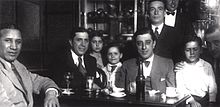This is an old revision of this page, as edited by Jevansen (talk | contribs) at 11:47, 24 July 2023 (Moving from Category:People from Buenos Aires to Category:Musicians from Buenos Aires using Cat-a-lot). The present address (URL) is a permanent link to this revision, which may differ significantly from the current revision.
Revision as of 11:47, 24 July 2023 by Jevansen (talk | contribs) (Moving from Category:People from Buenos Aires to Category:Musicians from Buenos Aires using Cat-a-lot)(diff) ← Previous revision | Latest revision (diff) | Newer revision → (diff) Argentine musician| This article needs additional citations for verification. Please help improve this article by adding citations to reliable sources. Unsourced material may be challenged and removed. Find sources: "Pedro Maffia" – news · newspapers · books · scholar · JSTOR (August 2009) (Learn how and when to remove this message) |


Pedro Mario Maffia (August 28, 1899 – October 16, 1967) was an Argentine tango bandoneonist, bandleader, composer and teacher, as well as starring in several tango films.
The son of Italian immigrants Angelo V. Maffia and Luisa Spinelli from Lombardy, Maffia had a hard upbringing; he was beaten with a chain by his father and lived in dire poverty. He eventually ran away from home to live in the town of Punta Alta in Buenos Aires Province, where he was discovered by Carlos Gardel and José Razzano.
Maffia is remembered as a pioneer of the bandoneon and a great stylist. He was one of the first to play the instrument a cappella. He had a relaxed playing style and an inventiveness for misplaced accents and nuances.
Maffia starred in a number of tango films including ¡Tango! (1933), Canillita (1936) and Fueye querido (1966). He also worked as a music teacher, and wrote an important method of teaching the bandoneon.
The bandoneonist Aníbal Troilo dedicated a song to him entitled A Pedro Maffia.
External links
- Pedro Maffia at todotango.com
- Pedro Maffia at tango.info